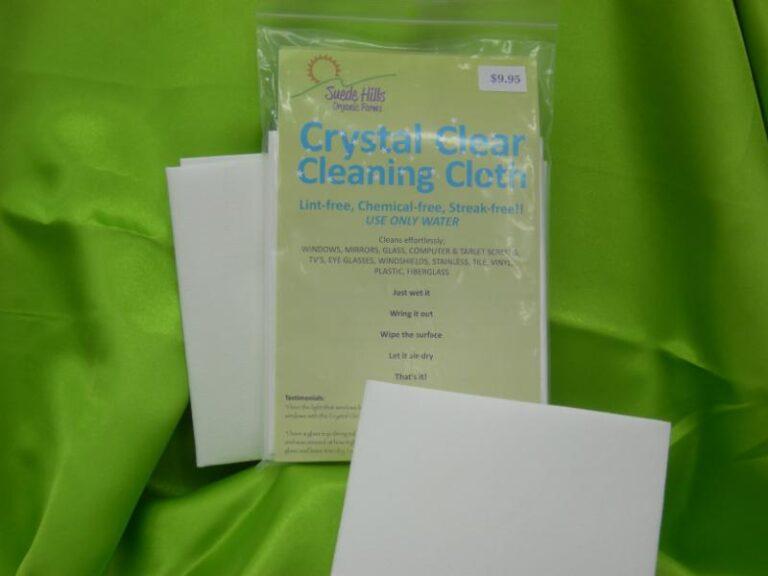Clean Without Chemicals!!
Introducing the “Crystal Clear Cleaning Cloths”
Lint-free, Chemical -free, Streak-free! Use only water!!
Cleans:
- Windows, Mirrors, Glass,
- Computer and Tablet Screens,
- Eye Glasses, Windshields, TV’s, Cell Phones
Two, 16×16 inch cloths for only $9.95
(You can cut them to any size to suit the job that needs to be done)

“I actually enjoy doing my windows now! My eye glasses have never been so clean, and now all those grubby fingerprints are easy to get off my tablet. Amazing how such a little thing can make such a big difference.”
CJ
Do You Know What is in Your Personal Care Products?
Chances are that even if you read the ingredients list you wouldn’t know much more than you did before! We have chosen two very common personal care products that contain some unsavory chemicals.
Toothpaste
Our first personal care product is toothpaste.
The most common chemical in toothpaste is Fluoride. This chemical is a KNOWN poison, that’s why the back of your toothpaste says ‘If large amount is swallowed call poison control centre’.
Fluoride can corrode the tooth enamel, when swallowed can lead to Crohn’s disease, can cause dental fluorosis, arthritis, and causes allergic reactions. Triclosan is used as an antimicrobial and has been shown to promote the emergence of antibiotic resistant bacteria, interfere with thyroid hormones, and the American Medical Association suggests that consumers should check product ingredients for this chemical under the names Triclosan, tricocarban, quaternary ammonium, and microban.
Shampoo
Shampoo is our second most common personal care product that most people use. A very common chemical for this is Sodium Lauryl Sulphate (SLS) which is sometimes referred to as ‘derived from coconut’ but don’t be fooled, it is chemically produced!
SLS degenerates cell membranes and can change genetic information in cells(mutagenic) and can damage the immune system. It also causes eye irritation, skin rashes, hair loss, dandruff and allergic reactions. Diethylene Glycol (DEG) is often used in shampoo, these ethylene glycol groups are carcinogenic, toxic, easily absorbed through the skin, and mutagenic. FD &C Blue No. 1&2 which are artificial colouring dyes that are derived from crude oil and synthesized from petroleum. These dyes can trigger a number of behavioural, comprehension, and health issues. They can also cause severe allergic reactions, asthma, headaches, nausea, fatigue, nervousness, and cancer.
Deodorant
Do you use Deodorant or an Antiperspirant? If you do then these are the chemicals to watch for. Ethanol, which is on the EPA’s Hazardous Waste List, is commonly used in deodorants. This chemical can create fatigue, can be irritating to the eyes and upper respiratory tract even in low concentrations.
Shaving Cream
Shaving Cream is a common personal care product you see in almost everyone’s house. This shaving facilitator is filled with chemicals. One common chemical is Isobutane, which is used as a propellant, It is a suspected neurotoxicant and its use is banned in cosmetics by the EU. Another very common chemical in shaving cream is Acetic Acid which is toxic to the skin. Keep an eye out for Butylated Hydroxytoluene as well as it has been been identified as a suspected neurotoxin as well as a skin or sense organ toxin.
Gel / Hair Products
The last most common personal care product is gel/hair products. Hair products often contain Sodium Lauryl Suflate/Sodium Laureth Sulfate (SLS): Both of these are cheap, harsh detergents. These sulfates are generally derived from petroleum and often cause eye irritation, scalp irritation and tangled hair. Also watch out for Parabens (methyl, propyl, butyl, and ethyl): Parabens are added to hair products because they act as preservatives. Unfortunately, parabens are also estrogenic and disruptive of normal hormone function. Exposure to these parabens has been linked to Breast Cancer. Parabens are also known to cause allergic and skin reactions. The last and probably most common to watch for is Synthetic Colors & Dyes: Colors & Dyes are commonly used to make products look pretty. Colors & Dyes are created from coal tar and may deposit toxins onto the skin, which can cause irritation. Research has shown that nearly all synthetic colors and dyes are carcinogenic. Check your label for something that looks like this: FD&C Red No.6 or D&C No.6.
Avoiding these chemicals when you buy your personal care products is a great start on cutting out the unsavory chemicals that are put into our prepackaged products. You may want to look for 100% natural alternatives, as most of the big companies cut costs by using these and other chemicals because they are cheap.
